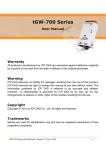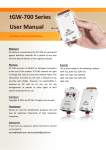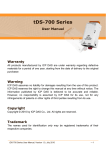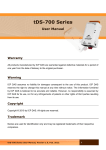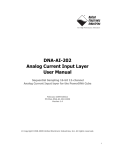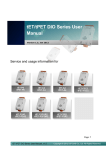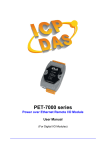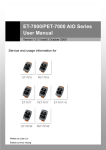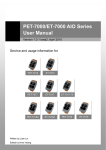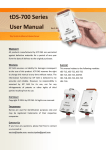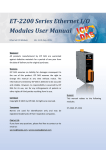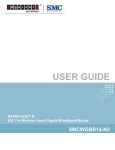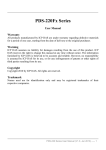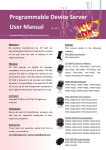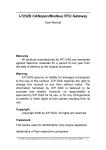Download Manual - ICP DAS USA`s I
Transcript
tGW-700 Series User Manual Warranty All products manufactured by ICP DAS are warranted against defective materials for a period of one year from the date of delivery to the original purchaser. Warning ICP DAS assumes no liability for damages consequent to the use of this product. ICP DAS reserves the right to change this manual at any time without notice. The information furnished by ICP DAS is believed to be accurate and reliable. However, no responsibility is assumed by ICP DAS for its use, nor for any infringements of patents or other rights of third parties resulting from its use. Copyright Copyright © 2010 by ICP DAS. All rights are reserved. Trademark Names are used for identification only and may be registered trademarks of their respective companies. tGW-700 Series User Manual, Version 1.6, Jul. 2011 1 Table of Contents PACKING LIST .......................................................................................................................................................................5 MORE INFORMATION ........................................................................................................................................................5 1. INTRODUCTION ..........................................................................................................................................................6 1.1 WHY ETHERNET SOLUTIONS?......................................................................................................................................7 1.2 WHY WEB SERVER TECHNOLOGY?..............................................................................................................................8 2. HARDWARE INFORMATION...................................................................................................................................9 2.1 SPECIFICATIONS ............................................................................................................................................................9 2.2 FEATURES .......................................................................................................................................................................10 2.3 SELECTION GUIDE........................................................................................................................................................10 2.4 TGW-700 2.5 DIMENSIONS .................................................................................................................................................................13 2.6 PIN ASSIGNMENTS .......................................................................................................................................................15 2.7 FRONT VIEW ............................................................................................................................................11 2.6.1 tGW-712 Pin Assignments .....................................................................................................................15 2.6.2 tGW-722 Pin Assignments .....................................................................................................................16 2.6.3 tGW-732 Pin Assignments .....................................................................................................................17 2.6.4 tGW-715 Pin Assignments .....................................................................................................................18 2.6.5 tGW-725 Pin Assignments .....................................................................................................................19 2.6.6 tGW-735 Pin Assignments .....................................................................................................................20 2.6.7 tGW-718 Pin Assignments .....................................................................................................................21 2.6.8 tGW-724 Pin Assignments .....................................................................................................................22 2.6.9 tGW-734 Pin Assignments .....................................................................................................................23 WIRING NOTES ............................................................................................................................................................24 2.7.1 RS-232 Wiring Connections ..................................................................................................................24 2.7.1 RS-422 Wiring Connections ..................................................................................................................25 2.7.2 RS-485 Wiring Connections ..................................................................................................................25 3. SETTING UP THE TGW-700 MODULE ...............................................................................................................26 STEP 1: CONNECTING THE POWER AND HOST PC ..........................................................................................................26 STEP 2: INSTALLING THE MODBUS UTILITY AND ESEARCH UTILITY .........................................................................27 STEP 3: SEARCH FOR THE TGW-700 ON THE ETHERNET NETWORK ...........................................................................28 STEP 4: TESTING YOUR TGW-700.....................................................................................................................................29 4. WEB CONFIGURATION ...........................................................................................................................................33 tGW-700 Series User Manual, Version 1.6, Jul. 2011 2 4.1 LOGGING IN TO THE TGW-700 WEB SERVER .......................................................................................................33 4.2 HOME PAGE ....................................................................................................................................................................35 4.3 4.4 NETWORK SETTING ....................................................................................................................................................36 4.3.1 Network and Miscellaneous Settings .................................................................................................36 4.3.2 IP Address Selection ................................................................................................................................36 4.3.3 General Configuration Settings............................................................................................................39 4.3.4 Restore Factory Defaults........................................................................................................................40 SERIAL PORT SETTINGS ............................................................................................................................................41 4.4.1 Port1 Settings.............................................................................................................................................41 4.4.2 Port Settings ...............................................................................................................................................41 4.4.3 Pair-Connection Settings........................................................................................................................42 4.5 CHANGE PASSWORD ...................................................................................................................................................43 4.6 LOGOUT .........................................................................................................................................................................43 5. TYPICAL APPLICATIONS FOR THE TGW-700 ............................................................................................44 5.1 MODBUS GATEWAY ......................................................................................................................................................44 5.2 PAIR-CONNECTION APPLICATIONS .........................................................................................................................45 STEP 1: CONNECTING TO A NETWORK, PC AND POWER ...............................................................................................46 STEP 2: CONFIGURING ETHERNET SETTINGS ..................................................................................................................47 STEP 3: CONFIGURING PAIR-CONNECTION ON TGW-700 #1 WEB SERVER .........................................................47 STEP 4: CONFIGURING PAIR-CONNECTION ON TGW-700 #2 WEB SERVER .........................................................49 STEP 5: TESTING PAIR-CONNECTION FUNCTION ..........................................................................................................49 APPENDIX: GLOSSARY ...................................................................................................................................................52 1. ARP (ADDRESS RESOLUTION PROTOCOL).............................................................................................................52 2. CLIENTS AND SERVERS ................................................................................................................................................52 3. ETHERNET ........................................................................................................................................................................53 4. FIRMWARE ......................................................................................................................................................................53 5. GATEWAY ........................................................................................................................................................................53 6. ICMP (INTERNET CONTROL MESSAGES PROTOCOL) ..........................................................................................53 7. INTERNET ........................................................................................................................................................................53 8. IP (INTERNET PROTOCOL) ADDRESS .......................................................................................................................53 9. MAC (MEDIA ACCESS CONTROL) ADDRESS ...........................................................................................................54 10. PACKET ............................................................................................................................................................................54 11. PING .................................................................................................................................................................................54 12. RARP (REVERSE ADDRESS RESOLUTION PROTOCOL)........................................................................................54 13. SOCKET ............................................................................................................................................................................54 14. SUBNET MASK ................................................................................................................................................................55 15. TCP (TRANSMISSION CONTROL PROTOCOL) ........................................................................................................55 tGW-700 Series User Manual, Version 1.6, Jul. 2011 3 16. TCP/IP...........................................................................................................................................................................55 17. UDP (USER DATAGRAM PROTOCOL).......................................................................................................................55 APPENDIX: FAQ ..................................................................................................................................................................56 1. HOW TO AVOID A BROWSER ACCESS ERROR THAT CAUSES A BLANK PAGE TO BE DISPLAYED WHEN USING IE. .....................................................................................................................................................................................56 2. HOW TO ACCESS A REMOTE TGW-700 THAT IS LOCATED PLACED BEHIND AN NAT OR A FIREWALL. .....58 3. WHY DOES THE TGW-700 SERIES MODULE FAIL ON A (PUBLIC) INTERNET CONNECTION? ......................59 4. WHY CANNOT COMPUTER PING OR SEARCH THE TGW-700 SERIES MODULE? ...............................................61 tGW-700 Series User Manual, Version 1.6, Jul. 2011 4 Packing List The shipping package includes the following items: One tGW-700 series hardware module One printed Quick Start Guide One software utility CD Quick start Note: If any of these items are missing or damaged, please contact the local distributor for more information. Save the shipping materials and cartons in case you want to ship the module in the future. More Information Documentation CD:\NAPDOS\tGW-700\Document http://ftp.icpdas.com/pub/cd/tinymodules/napdos/tgw-700/document/ Firmware CD:\NAPDOS\tGW-700\Firmware http://ftp.icpdas.com/pub/cd/tinymodules/napdos/tgw-700/firmware/ Software CD:\NAPDOS\Software http://ftp.icpdas.com/pub/cd/tinymodules/napdos/software/ tGW-700 Series User Manual, Version 1.6, Jul. 2011 5 1. Introduction Modbus has become a de facto standard industrial communication protocol, and is now the most commonly available means of connecting industrial electronic devices. Modbus allows for communication between many devices connected to the same RS-485 network, for example, a system that measures temperature and humidity and communicates the results to a computer. Modbus is often used to connect a supervisory computer with a remote terminal unit (RTU) in supervisory control and data acquisition (SCADA) systems. The tGW-700 module is a Modbus TCP/UDP to RTU/ASCII gateway that enables a Modbus/TCP host to communicate with serial Modbus RTU/ASCII devices through an Ethernet network, and eliminates the cable length limitation of legacy serial communication devices. The module can be used to create a pair-connection application (as well as serial-bridge or serialtunnel application), and can then route data over TCP/IP between two serial Modbus RTU/ASCII devices, which is useful when connecting mainframe computers, servers or other serial devices that use Modbus RTU/ASCII protocols and do not themselves have Ethernet capability. The tGW-700 module features a powerful 32-bit MCU to enable efficient handling of network traffic, and also has a built-in web server that provides an intuitive web management interface that allows users to modify the configuration of the module, including the DHCP/Static IP, the gateway/mask settings and the serial port settings The tGW-700 module offers true IEEE 802.3af-compliant (classification, Class 1) Power over Ethernet (PoE) functionality using a standard category 5 Ethernet cable to receive power from a PoE switch such as the NS-205PSE. If there is no PoE switch on site, the module will also accept power input from a DC adapter. The tGW-700 module is designed for ultra-low power consumption, reducing hidden costs from increasing fuel and electricity prices, especially when you have a large number of modules installed. Reducing the amount of electricity consumed by choosing energy-efficient equipment can have a positive impact on maintaining a green environment. tGW-700 Series User Manual, Version 1.6, Jul. 2011 6 Comparison Table of Device Servers: Series Features Virtual COM Programmable PoE Modbus Gateway Multi-client Remarks PPDS PDS DS tDS tGW Yes Yes Yes Yes Yes Yes Yes Yes Professional Powerful Yes Yes Isolation for DS-715 Yes Yes Cost-effective, Entry-level Yes Yes Cost-effective, Entry-level 1.1 Why Ethernet Solutions? Nowadays, the Ethernet protocol has become the de-facto standard for local area networks. Connectivity via the Internet is becoming common in many applications from home appliances, to vending machines, to testing equipment, to UPS, etc. An Ethernet network can link office automation and industrial control networks, access remote systems and share data and information between multivendor machines, and it also provides a cost-effective solution for industrial control networks. tGW-700 Series User Manual, Version 1.6, Jul. 2011 7 1.2 Why Web Server Technology? Web server technology enables configuration of the tGW-700 via a standard web browser interface, e.g. Internet Explorer, Firefox or Mozilla, etc. This means that it is easy to check the configuration of the tGW-700 via an Ethernet network without needing to install any other software tools, thereby reducing the user’s learning curve. tGW-700 Series User Manual, Version 1.6, Jul. 2011 8 2. Hardware Information 2.1 Specifications Model tGW-712 tGW-722 tGW-732 tGW-715 tGW-725 tGW-735 tGW-718 2-wire RS-485 3-wire RS-232 2-wire RS-485 4-wire RS-422 tGW-724 tGW-734 2-wire RS-485 2-wire RS-485 5-wire RS-232 3-wire RS-232 3-wire RS-232 System CPU 32-bit ARM Communication Interface 10/100 Base-TX, 8-pin RJ-45 x 1, Ethernet (Auto-negotiating, Auto-MDI/MDIX, LED indicator) PoE (IEEE 802.3af, Class 1) COM1 5-wire RS-232 5-wire RS-232 3-wire RS-232 COM2 - 5-wire RS-232 COM3 - - 3-wire RS-232 3-wire RS-232 Self-Tuner UART COM Port Format Baud Rate Data Bit Parity Stop Bit General 16c550 or compatible PoE: IEEE 802.3af, Class 1 DC jack: +12 ~ 48 VDC Power Consumption 0.05 A @ 24 VDC Installation Flammability Operating Temperature Storage Temperature Humidity 2-wire RS-485 2-wire RS-485 2-wire RS-485 Yes, automatic RS-485 direction control - 2-wire RS-485 - 115200 bps Max. 5, 6, 7, 8 None, Odd, Even, Mark, Space 1, 2 Power Input Connector 2-wire RS-485 4-wire RS-422 Male 10-Pin Removable Terminal Block x 1 DB-9 x1 DIN-Rail mounting Fire Retardant Materials (UL94-V0 Level) -25° ~ 75°C -30° ~ 80°C 10 ~ 90% RH, non-condensing Note: COM1/COM2/COM3 = TCP port 502/503/504 tGW-700 Series User Manual, Version 1.6, Jul. 2011 9 2.2 Features Cost-effective Modbus/TCP to RTU/ASCII Gateway Supports Modbus/TCP master and slave Supports Modbus RTU/ASCII master and slave Contains a 32-bit MCU that efficiently handles network traffic 10/100 Base-TX Ethernet, RJ-45 x1 (Auto-negotiating, auto MDI/MDIX, LED Indicators) Redundant power inputs: PoE (IEEE 802.3af, Class 1) and DC jack Includes redundant power inputs: PoE and DC jack Allows automatically RS-485 direction control Supports TCP, UDP, HTTP, DHCP, BOOTP and TFTP protocols Supports UDP responder for device discovery Allows easy firmware updates via the Ethernet Tiny Built-in Web server for easy configuration Tiny form-factor and low power consumption RoHS compliant with no Halogen Made from high-grade fire retardant materials (UL94-V0 Level) 2.3 Selection Guide Model CPU Ethernet Baud Rate tGW-712 tGW-722 tGW-732 tGW-715 tGW-725 tGw-735 32-bit MCU 10/100 Base-TX, PoE 115200 bps tGW-718 tGW-724 tGW-734 3-Wire 5-Wire 2-Wire 4-Wire RS-232: RS-232: RS-485: RS-422: COM1 5-wire RS-232 5-wire RS-232 3-wire RS-232 2-wire RS-485 4-wire RS-422 2-wire RS-485 2-wire RS-485 3-wire RS-232 2-wire RS-485 4-wire RS-422 2-wire RS-485 2-wire RS-485 COM2 3-wire RS-232 - - 2-wire RS-485 2-wire RS-485 2-wire RS-485 - - 5-wire RS-232 - 3-wire RS-232 3-wire RS-232 RxD, TxD, GND (Non-isolated) RxD, TxD, CTS, RTS, GND (No-isolated) DATA+, DATA-, GND (Non-isolated) TxD+, TxD-, RxD+, RxD-, GND (Non-islated) tGW-700 Series User Manual, Version 1.6, Jul. 2011 COM3 5-wire RS-232 3-wire RS-232 10 2.4 tGW-700 Front View Serial COM Ports Robust insulated and fire retardant case S1: System LED indicator Operating Mode Switch PoE and Ethernet RJ-45 Jack +12~+48 VDC Jack 1. PoE and Ethernet RJ-45 Jack: The tGW-700 is equipped with a RJ-45 jack that is used as the 10/100 Base-TX Ethernet port and features networking capability. When an Ethernet link is detected and an Ethernet packet is received, the Link/Act LED (Orange) indicator will be illuminated. When power is supplied via PoE (Power-over-Ethernet), the PoE LED (Green) indicator will be illuminated. tGW-700 Series User Manual, Version 1.6, Jul. 2011 11 2. +12~+48 VDC Jack: The tGW-700 is equipped with a +12~+48 VDC jack that is used as the power supply. If there is no PoE switch available on site, the tGW-700 will accepts power input from a DC adapter. 3. S1: System LED indicator: Once power is supplied to the tGW-700, the system LED indicator will be illuminated as follows: Function System LED Behavior Running Firmware ON Network ready Flashing per 3 seconds Serial Port Busy Flashing per 0.2 seconds 4. Operating Mode Switch: Init Mode: Configuration mode Run Mode: Firmware operation mode In the tGW-700 series, the operating mode Switch is in the Run position by default. When updating the tGW-700 firmware, the switch needs to be moved from the Run position to the Init position. The Switch must be returned to the Run position after the update is complete. 5. Serial COM Ports: The numbers of serial COM Ports depend on the types of tGW-700 modules. For more detailed information regarding the pin assignments for the Serial COM ports, please refer to Section 2.6 Pin Assignments. tGW-700 Series User Manual, Version 1.6, Jul. 2011 12 2.5 Dimensions tGW-712 Dimensions: Units: mm Rear View Front View Top View Left Side View Right Side View tGW-700 Series User Manual, Version 1.6, Jul. 2011 Bottom View 13 tGW-722/732/715/725/735/718/724/734 Dimensions: Units: mm Front View Rear View Top View Left Side View Right Side View tGW-700 Series User Manual, Version 1.6, Jul. 2011 Bottom View 14 2.6 Pin Assignments 2.6.1 tGW-712 Pin Assignments 1-Port 5-wire RS-232 Module Note: The CTS/RTS pins are reserved (no function). tGW-700 Series User Manual, Version 1.6, Jul. 2011 15 2.6.2 tGW-722 Pin Assignments 2-Port 5-wire RS-232 Module Note: The CTS/RTS pins are reserved (no function). tGW-700 Series User Manual, Version 1.6, Jul. 2011 16 2.6.3 tGW-732 Pin Assignments 3-Port 3-wire RS-232 Module tGW-700 Series User Manual, Version 1.6, Jul. 2011 17 2.6.4 tGW-715 Pin Assignments 1-Port 2-wire RS-485/4-Wire RS-422 Module tGW-700 Series User Manual, Version 1.6, Jul. 2011 18 2.6.5 tGW-725 Pin Assignments 2-Port 2-wire RS-485 Module tGW-700 Series User Manual, Version 1.6, Jul. 2011 19 2.6.6 tGW-735 Pin Assignments 3-Port 2-wire RS-485 Module tGW-700 Series User Manual, Version 1.6, Jul. 2011 20 2.6.7 tGW-718 Pin Assignments 1-Port 3-Wire R232 and 2-Wire RS-485/4-Wire RS-422 Module tGW-700 Series User Manual, Version 1.6, Jul. 2011 21 2.6.8 tGW-724 Pin Assignments 1-Port 2-Wire RS-485 and 1-Port 5-Wire RS-232 Module Note: The CTS/RTS pins are reserved (no function). tGW-700 Series User Manual, Version 1.6, Jul. 2011 22 2.6.9 tGW-734 Pin Assignments 1-Port 2-Wire RS-485 and 2-Port 3-Wire R232 Module tGW-700 Series User Manual, Version 1.6, Jul. 2011 23 2.7 Wiring Notes 2.7.1 RS-232 Wiring Connections Note: FGND is the frame ground that is soldered to the DB9 metal-shield. tGW-700 Series User Manual, Version 1.6, Jul. 2011 24 2.7.1 RS-422 Wiring Connections 2.7.2 RS-485 Wiring Connections Note: You should connect all signal grounds of RS-422/485 devices together. This reduces the common-mode voltage between devices. tGW-700 Series User Manual, Version 1.6, Jul. 2011 25 3. Setting up the tGW-700 module Step 1: Connecting the power and Host PC 1. Make sure the network settings on your PC are functioning correctly. 2. Disable or correctly configure the Windows firewall and any Anti-Virus software firewall first or else the “Search Servers” function in the eSearch Utility may not work. (Contact your System Administrator for more details of how to do this) 3. Check Init/Run switch is on Run position. 4. Connect both the tGW-700 and your computer to the same sub-network or the same Ethernet Switch and power on the tGW-700. tGW-700 Series User Manual, Version 1.6, Jul. 2011 26 5. Make sure the System LED indicator is flashing. Step 2: Installing the Modbus Utility and eSearch Utility The Modbus Utility is located at: CD: \NAPDOS\Software\Modbus_Utility http://ftp.icpdas.com/pub/cd/tinymodules/napdos/software/modbus_utility/ The eSearch Utility is located at: CD:\Napdos\software\eSearch\ http://ftp.icpdas.com/pub/cd/tinymodules/napdos/software/esearch/ tGW-700 Series User Manual, Version 1.6, Jul. 2011 27 Step 3: Search for the tGW-700 on the Ethernet network 1. Double click the eSearch Utility and click the “Search Servers” button to search for your tGW-700. 2. Double click the name of the tGW-700 to open the “Configure Server” dialog box. 2. Double-Click your tGW-700 1. Click “Search Servers” 3. Contact your Network Administrator to obtain the correct network configuration information such as IP/Mask/Gateway. Enter the network settings and then click “OK”. The tGW-700 will use the new settings within 2 seconds. tGW-700 Series User Manual, Version 1.6, Jul. 2011 28 Step 4: Testing your tGW-700 4. Wiring to the Modbus device (ex: M-7055D, optional) with your tGW-700 (RS-485 bus). For detailed RS-232/422/485 wiring information, refer to Section 2.7 Wiring Note. RS-232 Wiring: RS-485 Wiring: tGW-700 Series User Manual, Version 1.6, Jul. 2011 29 5. Enter the URL address of tGW-715 in the browser, or click the “Web” button on the eSearch Utility. 6. Enter the password (default: admin) in the login password field, and then click the “Submit” button to enter the configuration web page. 7. Select the “Modbus RTU or Modbus ASCII” option from the Modbus protocol that is used by the attached Modbus devices. Note: Only one protocol can be used in a serial port. tGW-700 Series User Manual, Version 1.6, Jul. 2011 30 8. Double click the Modbus Utility shortcut on the desktop, and then click the “Modbus/TCP” button. Double-Click 9. Click on the “Client tools” >> “Modbus/TCP Client”. tGW-700 Series User Manual, Version 1.6, Jul. 2011 31 10. Enter the IP address of tGW-700 and then click “Connect” button to connect the tGW700. 11. Refer to the field "Protocol Description" at the top right of the program. You can send a request command and confirm the response is correct. (Ex: If M-7000 Modbus device ID = 1, you send “1 2 0 0 0 6 1 2 0 0 0 4” for reading D/I value, you may receive response “1 2 0 0 0 4 1 2 1 0”) 1 2 3 Success tGW-700 Series User Manual, Version 1.6, Jul. 2011 32 4. Web Configuration Once the tGW-700 module has been correctly configured and is functioning on the network normally, the configuration details can be retrieved or modified using either the eSearch Utility or a standard web browser. 4.1 Logging in to the tGW-700 Web server You can log on to the tGW-700 web server from any computer that has Internet access. Step 1: Open a browser Mozilla Firefox, Google Chrome and Internet Explorer, for example are reliable and popular internet browsers that can be used to configure tGW-700 modules. If using IE, disable the cache to prevent browser access errors. For detailed settings information refer to “Appendix: FAQ 1”. Step 2: Type the URL address of the tGW-700 Make sure you have correctly configured the network settings for the tGW-700, or refer to Section 3 Setting up the tGW-700 module. tGW-700 Series User Manual, Version 1.6, Jul. 2011 33 Step 3: Enter the Password After entering the IP address, the login dialog page will be displayed. Enter the password, and then click the “Submit” button to enter the configuration web page. The factory default password is: Item Default Login password admin Step 4: Welcome to tGW-700 web server After logging onto the tGW-700 web server, the main page will appear. tGW-700 Series User Manual, Version 1.6, Jul. 2011 34 4.2 Home Page The Home link connects to the main page, which contains two parts. The first part of this page provides basic information about the tGW-700 hardware and software. The second part of this page provides the status of the port settings and pair-connection settings. tGW-700 Series User Manual, Version 1.6, Jul. 2011 35 4.3 4.3.1 Network Setting Network and Miscellaneous Settings Check the model name and the software information. The software information includes the following items: Firmware Version, Model Name, IP Address, Initial Switch, MAC Address and System Timeout. After updating the tGW-700 firmware, you can check the version information on this page. 4.3.2 IP Address Selection The Address Type, Static IP Address, Subnet Mask and Default Gateway items are the most important network settings and should always correspond to the LAN configuration. If they do not match, the tGW-700 module will not operate correctly. If the settings are changed while the module is operating, any linked connection currently in use will be lost and an error will occur. tGW-700 Series User Manual, Version 1.6, Jul. 2011 36 Item Descriptions: Item Description Static IP: If you don’t have a DHCP server in your network, you can configure the network settings manually. Please refer to the Section 4.3.2.1 Manually Configuration Address Type DHCP/AutoIP: Dynamic Host Configuration Protocol (DHCP) is a network application protocol that automatically assigns an IP address to each device. Please refer to Section 4.3.2.2 Dynamic Configuration Static IP Address Each tGW-700 on the network must have a unique IP address. This item used to assign specific IP address. Subnet Mask The subnet mask indicates which portion of the IP address is used to identify the local network or subnet. Default Gateway A gateway (or router) is a system that is used to connect an individual network with one or more additional networks. MAC Address The user-defined MAC address. Update Settings Click this button to save the new settings to the tGW-700. tGW-700 Series User Manual, Version 1.6, Jul. 2011 37 Network settings can be configured using either dynamic configuration or manually configuration, as per the following instructions: 4.3.2.1 Manual Configuration When using manual configuration, you have to assign all the network settings in the following manner: Step 1: Select “Static IP” as the address type Step 2: Enter the appropriate network settings Step 3: Click the “Update Settings” button to finish the configuration 4.3.2.2 Dynamic Configuration Dynamic configuration is very easy to perform. If you have a DHCP server, the network address can be dynamically configured in the following manner: Step 1: Select “DHCP/AutoIP” as the address type Step 2: Click the“Update Settings” button to finish configuration tGW-700 Series User Manual, Version 1.6, Jul. 2011 38 4.3.3 General Configuration Settings The General Configuration Settings provides functions allowing items such as the Alias Name, System Timeout value, and Auto-logout value to be configured. Item Descriptions: Item Alias Name System Timeout (Network Watchdog) Description Default Each tGW-700 can be allocated a unique Alias name so that it can be identified the network. If no network communication occurs for a certain period, the system will be rebooted based on the configured system timeout value. Tiny 0 Settings range: 30 ~ 65535 (seconds); Disabled = 0; If there is no action for a certain period in the web server, user account will be logout. Web Auto-logout 10 Settings range: 1 ~ 65535 (minutes); Disabled = 0; Update Settings Click this button to save the new settings to the tGW-700. tGW-700 Series User Manual, Version 1.6, Jul. 2011 39 4.3.4 Restore Factory Defaults To reset the settings to their factory default, follow these steps: Step 1: Click the “Restore Defaults” button to reset the configuration. Step 2: Click the “OK” button in the message dialog box. Step 3: Check whether the tGW-700 is reset to factory default settings for use with the eSearch Utility. Refer to the Section 3 Setting up the tGW-700 Module Default Settings: Item Factory Default Settings IP 192.168.255.1 Gateway 192.168.0.1 Mask 255.255.0.0 tGW-700 Series User Manual, Version 1.6, Jul. 2011 40 4.4 Serial Port Settings 4.4.1 Port1 Settings Check the tGW-700 hardware and software information. 4.4.2 Port Settings The port settings provide the following functions: tGW-700 Series User Manual, Version 1.6, Jul. 2011 41 Item Descriptions: Item Description Default Baud Rate (bps) Sets the Bard Rate for the COM ports. Data Size (bits) Sets the Data Size for the COM ports. Sets the Parity for the COM ports. The tGW-700 does not support the Mark and Space functions. Parity 115200 Stop Bits (bits) Sets the Stop Bits of the COM ports. Local TCP Port Modbus TCP port Note: COM1/COM2/COM3 = TCP port 502/503/504 If the Local TCP port does not receive any data via the TCP/IP for a certain period, the tGW-700 will disconnect the socket based on the TCP timeout value. TCP Timeout(seconds) 8 None 1 502 180 Settings range: 1 ~ 65535 (seconds); Disabled = 0; Modbus Protocol Modbus RTU Modbus RTU or Modbus ASCII 4.4.3 Pair-Connection Settings The pair-connection provides the following functions: Item Descriptions: Item Server Settings Client Settings Server Mode Server Client Remote Server IP Disabled IP address of the remote device Remote TCP Port Disabled TCP Port number of the remote device Submit Click this button to save the new settings to the tGW-700. The more detailed information regarding pair-connection applications settings, please refer to the Section 5.2 Pair-Connection Applications tGW-700 Series User Manual, Version 1.6, Jul. 2011 42 4.5 Change Password Item Descriptions: Item Description Current password Enter the old password (default is admin) New password Enter the new password Confirm new password Enter the new password again Submit Click this button to save the new settings to the tGW-700. 4.6 Logout Click the “Logout” tag to log out from the system and return to the login page. tGW-700 Series User Manual, Version 1.6, Jul. 2011 43 5. 5.1 Typical Applications for the tGW-700 Modbus Gateway The tGW-700 module is a Modbus TCP/UDP to RTU/ASCII gateway that enables a Modbus TCP/UDP host to communicate with serial Modbus RTU/ASCII devices through an Ethernet network, and eliminates the cable length limitation of legacy serial communication devices. tGW-700 Series User Manual, Version 1.6, Jul. 2011 44 5.2 Pair-Connection Applications The tGW-700 device servers can be used to create a pair-connection application (as well as serial-bridge or serial-tunnel), and then route data between two serial devices via TCP/IP, which is useful when connecting mainframe computers, servers or other serial devices that do not themselves have Ethernet capability. Pair-Connection Settings Table: Port Settings (default) Model Pair-connection Settings Baud Rate Data Format Server Mode tGW-700 #1 115200 8N1 Client tGW-700 #2 115200 8N1 Server Remote TCP Port (default) Remote Server IP IP Address of the 502 tGW-700 #2 - - Note: The Baud Rate and data format settings of the client and server (tGW-700 #1 and #2) depend on the COM ports of the PC (or the connected device). The serial port settings can be different between the tGW-700 #1 and #2. tGW-700 Series User Manual, Version 1.6, Jul. 2011 45 Step 1: Connecting to a network, PC and Power 1. Confirm that the tGW-700 modules are functioning correctly. Refer to Section 3-1 Connecting the power and Host PC for more details. 2. Use a i-7520 module to connect COM1 of the PC to COM1 of the tGW-700 #1. For detailed RS-422/485 wiring information, refer to Section 2.7 Wiring Notes. (i-7520 Web site: http://www.icpdas.com/products/Remote_IO/i-7000/i-7520.htm) 3. Connect the Modbus device (Ex, M-7055D) with COM1 of the tGW-700 #2. (M-7055D Web site: http://www.icpdas.com/products/Remote_IO/m-7000/m-7055d.htm) For example of pair-connection test as follows: tGW-700 Series User Manual, Version 1.6, Jul. 2011 46 Step 2: Configuring Ethernet Settings Contact your Network Administrator to obtain a correct and functioning network configuration (such as IP/Mask/Gateway details) for tGW-700 modules. Please also refer to Section 3-3 Search the tGW-700 on the Ethernet network. Step 3: Configuring Pair-Connection on tGW-700 #1 Web server 1. Select your first tGW-715 (tGW-700#1) and click web button on the eSearch Utility to launch the browser program for connecting to the web server. 2. Enter the password (default: admin) in the Login password field, and then click the “Submit” button to enter the configuration page. 1 Figure 5-1 tGW-700 Series User Manual, Version 1.6, Jul. 2011 47 3. Click the “Port1” link to enter the settings page. 2 Figure 5-2 4. Select the appropriate Baud Rate, Data Format and Modbus Protocol settings from the relevant drop down options, for example “115200” , “8, None, 1” and “Modbus RTU”. 5. Select the “Client” option from the “Server Mode” drop down options and type the IP address of the tGW-700 #2 in “Remote Server IP” field. 6. Assign a TCP port for the tGW-700 #2 in the “Remote TCP Port” field and then click the “Submit” button to complete the configuration. 3 4 5 Figure 5-3 tGW-700 Series User Manual, Version 1.6, Jul. 2011 48 Step 4: Configuring Pair-Connection on tGW-700 #2 Web server 1. Enter the configuration page for the tGW-700 #2 web server. 2. Click the “Port1” link to enter the settings page of the tGW-700 #2. 3. Set the Baud Rate to “115200”, data format to “8, None, 1” and Modbus protocol to “Modbus RTU”. (Refer to Figures 5-1~5-3 for illustrations of how to perform the above steps.) 4. Select “Server” from the “Server Mode” drop down options and then click the “Submit” button to complete the configuration. Step 5: Testing Pair-Connection Function 1. Install the Modbus Utility, please refer to Section 3-2 Installing the Modbus Utility and eSearch Utility for more details. 2. Double click the Modbus Utility shortcut on the desktop, and then click the “Modbus/TCP” button. Double-Click tGW-700 Series User Manual, Version 1.6, Jul. 2011 49 3. Click on the “Client tools” >> “Modbus/RTU Client”. 3. Select the COM port number and settings and then click “Open” button. tGW-700 Series User Manual, Version 1.6, Jul. 2011 50 4. Refer to the field "Protocol Description" at the top right of the program. You can send a request command and confirm the response is correct. (Ex: If the remote Modbus device ID = 1, you send “1 2 0 0 0 4” for reading D/I value, you may receive response “1 2 1 0 A1 88”) (“A1 88” is the CRC value.) Note: The response is depending on the connected Modbus device. 1 2 3 Successful Note: The Baud Rate and Data Format depend on the serial port settings for the web configuration above. tGW-700 Series User Manual, Version 1.6, Jul. 2011 51 Appendix: Glossary 1. ARP (Address Resolution Protocol) Consider two machines A and B that share a physical network. Each has an assigned IP address IPA and IPB, and a MAC address, MACA and MACB. The goal is to devise low-level software that hides MAC addresses and allows higher-level programs to work only with the IP addresses. Ultimately, however, communication must be carried out by the physical networks using whatever MAC address scheme the hardware supplies. Suppose machine A wants to send a packet to machine B across a physical network to which they are both attached, but A only has the Internet address for B, IPB. The question arises: how does A map that address to the MAC address for B, MACB? ARP provides a method of dynamically mapping 32-bit IP address to the corresponding 48bit MAC address. The term dynamic is used since it happens automatically and is normally not a concern for either the application user or the system administrator. 2. Clients and Servers The client-server paradigm uses the direction of initiation to categorize whether a program is a client or server. In general, an application program that initiates peer-to-peer communication is called a client. End users usually invoke client programs when they use network services. Most client programs consist of conventional application program development tools. Each time a client program is executed, it contacts a server, sends a request and waits for a response. When the response arrives, the client program continues processing. Client programs are often easier to develop than servers, and usually require no special system privileges to operate. By comparison, a server is any program that waits for incoming requests from a client program. The server receives a request from a client, performs the necessary computation and returns the result to the client. tGW-700 Series User Manual, Version 1.6, Jul. 2011 52 3. Ethernet The term Ethernet generally refers to a standard published in 1982 by Digital Equipment Corp., Intel Corp. and Xerox Corp. Ethernet is the most popular physical layer local area network (LAN) technology today. Ethernet is a best-effort delivery system that uses CSMA/CD technology. It recognizes hosts using 48-bit MAC address. 4. Firmware Firmware is an alterable program located or stored in the semi-permanent storage area, e.g., ROM, EEPROM, or Flash memory. 5. Gateway Computers that interconnect two networks and pass packets from one to the other are called Internet Gateways or Internet Routers. Gateways route packets that are based on the destination network, not on the destination host. 6. ICMP (Internet Control Messages Protocol) No system works correctly all the time. ICMP provides a method of communicating between the Internet Protocol software on one machine and the Internet Protocol software on another. It allows gateways to send error or control messages to other gateways or allows a host to know what is wrong with the network communication. 7. Internet Physically, the Internet is a collection of packet switching networks interconnected by gateways that together with TCP/IP protocol, allows them to perform logically as a single, large and virtual network. The Internet recognizes hosts using 32-bit IP address. 8. IP (Internet Protocol) address Every interface on the Internet must have a unique IP address (also called an Internet address). These addresses are 32-bit numbers. They are normally written as four decimal numbers, one for each byte of the address such as “192.168.41.1”. This is called dotteddecimal notation. tGW-700 Series User Manual, Version 1.6, Jul. 2011 53 9. MAC (Media Access Control) address To allow a computer to determine which packets are meant for it, each computer attached to an Ethernet network is assigned a 48-bit integer known as its MAC address (also called an Ethernet address, hardware address or physical address). They are normally written as eight hexadecimal numbers such as “00:71:88:af:12:3e:0f:01”. Ethernet hardware manufacturers purchase blocks of MAC addresses and assign them in sequence as they manufacture the Ethernet interface hardware. Thus, no two hardware interfaces have the same MAC address. 10. Packet A packet is the unit of data sent across a physical network. It consists of a series of bits containing data and control information, including the source and the destination node (host) address, and is formatted for transmission from one node to another. 11. Ping Ping sends an ICMP echo request message to a host, expecting an ICMP echo reply to be returned. Normally, if a host cannot be pinged, you won’t be able to use Telnet or FTP to connect to the host. Conversely, if Telnet or FTP cannot be used to connect to a host, Ping is often the starting point to determine what the problem is. 12. RARP (Reverse Address Resolution Protocol) RARP provides a method of dynamically mapping 48-bit MAC address to the corresponding 32-bit IP address. 13. Socket Each TCP segment contains the source and destination port number that can be used to identify the sending and receiving application. These two values, along with the source and destination IP address in the IP header, uniquely identify each connection. The combination of an IP address and a port number is called a socket. tGW-700 Series User Manual, Version 1.6, Jul. 2011 54 14. Subnet Mask The Subnet mask is often simply called the mask. Given its own IP address and its subnet mask, a host can determine if a TCP/IP packet is destined for a host that is (1) on its own subnet, or (2) on a different network. If (1), the packet will be delivered directly; otherwise it, will be delivered via a gateway or router. 15. TCP (Transmission Control Protocol) TCP provides a reliable flow of data between two hosts and is associated with tasks such as dividing the data passed to it from applications into appropriately sized chunks for the network layer below, acknowledging received packets, setting timeouts to make certain that the other end acknowledges packets that are sent, and so on. 16. TCP/IP The Transmission Control Protocol (TCP) and the Internet Protocol (IP) are the standard network protocols. They are almost always implemented and used together in a formation is known as TCP/IP. TCP/IP can be used to communicate across any set of interconnected networks. 17. UDP (User Datagram Protocol) UDP provides a much simpler service to the application layer as if just sends packets of data from one host to the other, but there is no guarantee that the packets will reach the destination host. tGW-700 Series User Manual, Version 1.6, Jul. 2011 55 Appendix: FAQ 1. How to avoid a browser access error that causes a blank page to be displayed when using IE. Disable the IE cache in the following manner: Step 1: Click “Tools” “Tools >> “Internet Options...”. Step 2: Click the “General” tab and then click the “Settings...” button in the Temporary Internet files frame of the Internet Options dialog. tGW-700 Series User Manual, Version 1.6, Jul. 2011 56 Step 3: Select the “Every visit to the page” option and then click the “OK” button in both the Settings dialog and the Internet Options dialog. Step 4: Click the “Refresh” button or press F5 on your keyboard to refresh the tGW-700 web server or re-open IE. tGW-700 Series User Manual, Version 1.6, Jul. 2011 57 2. How to access a remote tGW-700 that is located placed behind an NAT or a firewall. The remote site must have an NAT server (or a router supports NAT). NAT stands for Network Address Translator. By using (configuring) the NAT server, NAT can forward (bypass) all specified TCP port connections to specified tGW-700 devices. For example: NAT: 502 maps to 192.168.1.101: 502 NAT: 512 maps to 192.168.1.102: 502 tGW-700 Series User Manual, Version 1.6, Jul. 2011 58 Please note, if your NAT (router) includes a built-in a firewall feature, you have to configure the NAT to allow incoming TCP port connections. For example: TCP port includes 502 and 512 of NAT. In the SCADA/HMI (Modbus/TCP client) program, you have to access tGW-700 by using NAT’s address and NAT’s TCP ports instead of tGW-700’s settings. For example: The first tGW-700, it’s IP: Port should be NAT: 502. The second tGW-700, it’s IP: Port should be NAT: 512. 3. Why does the tGW-700 series module fail on a (public) Internet connection? The default IP address of the tGW-700 series module is 192.168.255.1, which can be only used on a private Internet connection. A private network packet will not be routed via a (public) Internet connection, which is the reason why the tGW-700 series module fails on the Internet. The IANA has reserved three address spaces for private internets (RFC1918). 10.0.0.0 - 10.255.255.255 (10/8 prefix) 172.16.0.0 - 172.31.255.255 (172.16/12 prefix) 192.168.0.0 - 192.168.255.255 (192.168/16 prefix) tGW-700 Series User Manual, Version 1.6, Jul. 2011 59 However, tGW-700 series modules are to be operated on the Internet using a legal public IP address. This address can be obtained from your ISP or network administrator. A private internet client may communicate with a public Internet server (tGW-700 series module) only if the NAT service for the client is available. Note IANA RFC ISP NAT Internet Assigned Numbers Authority Request for Comments Internet Service Providers Network Address Translator tGW-700 Series User Manual, Version 1.6, Jul. 2011 60 4. Why cannot computer ping or search the tGW-700 series module? The computer can make a communication with the module through some specific ports. Please confirm with your network administrator that UDP Port 7, Port 57188 and Port 54321 can’t be denying by network device. About the detailed information of TCP/UDP port refers to following table: TCP Port: Description Port Number 80 502 503 504 HTTP (HyperText Transport Protocol) Modbus Data Port for COM1 Modbus Data Port for COM2 Modbus Data Port for COM3 UDP Port: Port Number 7 57188 54321 Description Echo (Ping) Request of UDP search Response of UDP search ICP DAS Web Site: http://www.icpdas.com Contact Us (E-Mail): [email protected] , [email protected] Copyright @ 2010 by ICP DAS Co., Ltd. All Rights Reserved.





























































